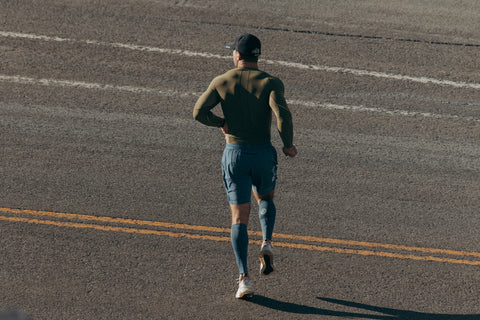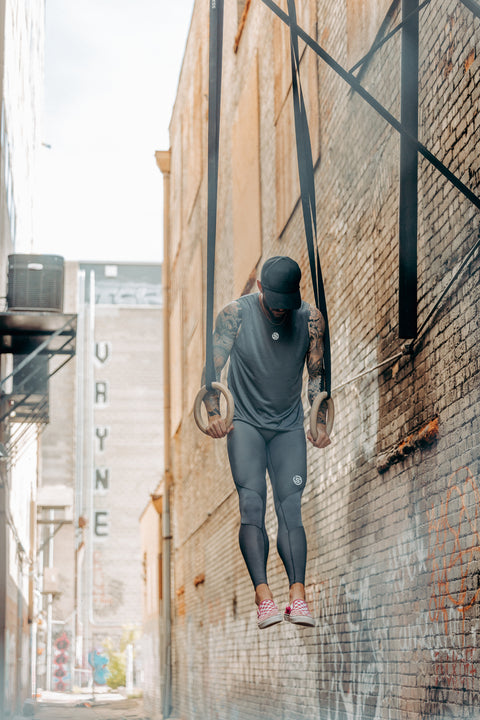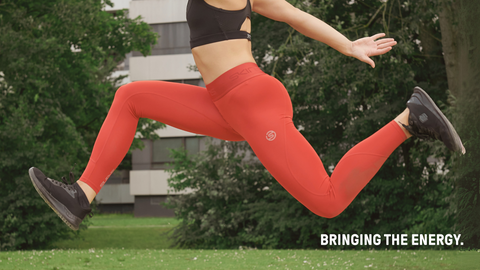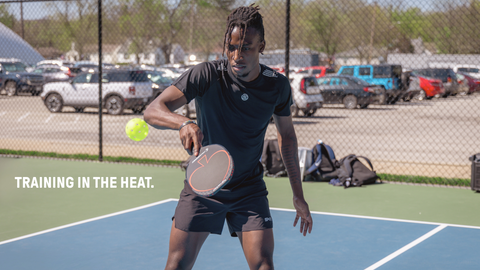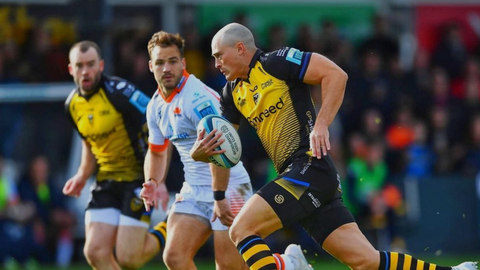BACKED BY RESEARCH
Over 25 years of research and testing has gone into SKINS Compression Sportswear. It was the first (and best) Compression Sportswear on the market in 1996, and to this day, it sits firmly at the top of the compression game thanks to its advanced technologies and intelligent designs.
SKINS gradient compression takes compression sportswear to another level. The engineering and technology involved ensures that athletes genuinely benefit from the compression they apply.
We're not just saying this. SKINS has been under the scientific and research microscope since it began all those years ago. In fact, we lead the industry with peer-reviewed journal publications. We're actually allowed to say that SKINS makes you a better athlete in both performance and recovery.
We're not going to give all of our secrets away, but the technology involved in our fabrics and even the stitching helps elevate SKINS to the next level.
The amount of research published on the functional parameters of SKINS is unrivaled within the sports compression wear industry. While other brands like to use our research to make general statements on the benefits of compression, we conduct our own in-depth research on our garments. We do this to ensure that the claims on the tin are what you will receive. No marketing hype, just a commitment to being true to the science.
- Dr Nic Gill, Strength and Conditioning Coach - Waikato Chiefs
- Dr Peter Clothier, Sports and Exercise Science Lecturer and Researcher - School of Biomedical & Health Sciences, University of Western Sydney, Australia
- Mr Dayne Walker, Researcher - School of Biomedical & Health Sciences, University of Western Sydney, Australia
- Jason McLaren, Research Consultant - iSPORT Biomechanics
- Melinda Wosik, Clinical Trials Coordinator - Western Sydney Area Health
- Laurence Houghton, Researcher - School of Human Movement and Exercise Science, The University of Western Australia
- Dr Ben Dascombe, Sports Science Lecturer - University of Newcastle, Australia
- Mr Aaron Scanlan, Research Lecturer - School of Medical and Applied Sciences, Faculty of Sciences, Engineering & Health, Central Queensland University
- Melissa Hagan, Clinical Researcher - MPRO
- Dr John Jakeman, Teaching Fellow; Strength and Conditioning - University of Abertay, Dundee
Mr Joshua Sear, Researcher - Central Queensland University and High-Performance Development Coordinator - Cycling Australia
- Ross Hanbury, Sport Scientist Harlequins Rugby Club - Department of Life Sciences, Roehampton University
- Chris McManus, Human Performance Unit Manager, The University of Essex, United Kingdom
- Kelly Murray, Human Performance Unit Sport Scientist, The University of Essex, United Kingdom
With numerous peer-reviewed studies conducted by some of the world's best and brightest, SKINS compression has many performance and recovery benefits
- Increases venous return
- Reduces exercise-induced muscle damage (EIMD)
- Accelerates recovery processes
- Removes lactic acid faster
- Increases strength and power
- Improves endurance
- Increases muscle oxygenation
- Improves body temperature control
- Reduces in-flight ankle oedema
Basically, SKINS compression gives you the benefit of a better performance without the pain.
If you're like us and want to understand the nitty-gritty of the science behind SKINS, check out the studies below. If you'd like to stay informed of the latest research and studies, sign up for our newsletter.
SKINS Increase Endurance Performance
- Do graduated compression garments improve field-hockey skill performance and repeated sprint ability following an intermittent endurance test? Heath, J. (2008) University of Chester. Unpublished
- Effect of lower-body compression garments on submaximal and maximal running performance in cold (10 degrees C) and hot (32 degrees C) environments. Goh, S. S., Laursen, P. B., Dascombe, B. & Nosaka, K. (2071) EurJ Appi Physiol, 111,879-26
- The Influence of lower-body compression clothing on markers of running economy during submaximal treadmill running. Bakken, B (2011) Montana State University. Unpublished
- The effects of whole-body compression garments on prolonged high-intensity intermittent exercise. Sear, J.H., Scanlon, A., Abt, G and Dascombe, B. (2070) Journal of Strength and Conditioning Research, 24 (7), 7907-7 970
- Effects of wearing compression garments on physiological and performance measures in a simulated game-specific circuit for netball. Higgins, T., Naughton, G.A. and Burgess, D. (2009) Journal of Science and Medicine in Spoil, 72, 223-226
SKINS Running Economy
- The Influence of SKINS A400 Lower Body Compression Garments on Running and Neuromuscular Performance. McManus, C., Murray, K. and Morgan, N. (2017) Human Performance Unit, The University of Essex.
SKINS Help to Increase Power
- The effects of wearing lower-body compression garments during endurance cycling. Scanlan, A., Dascombe, B., Reaburn, P. and Osbourne, M. (2008) International Journal of Sports Physiology, 3 (4)
- The effect of graduated compression garments (SKINSTM) on perceived leg pain, leg power and alertness following elite AFL matches. Lambert, S., Dongas, F., Parsons, B. & Turner, G. 2006, Journal of science and medicine in spoil! Spoils Medicine Australia, 9, 18
- The effects of SkinsTM compression garments on upper body strength. Lambert, S. & Dongas, F. 2006 Journal of science and medicine in sport / Spoils Medicine Australia, 9, 8
SKINS Help to Reduce the Risk of Injury and Speed up the Recovery Process
- Compression garments and recovery from eccentric exercise: A P-MRS study. Trenell, M.l., Rooney, K.B., Sue, C.M. and Thompson, C.H. (2006) Journal of Sports Science and Medicine, 5, 1 06-1 14
- Effectiveness of post-match recovery strategies in rugby players. Gill, ND., Beaven, C.M. and Cook, C. (2006) British Journal of Sports Medicine, 40, 260-263
- Efficacy of lower limb compression and combined treatment of manual massage and lower limb compression on symptoms of exercise-induced muscle damage in women. Jakeman, JR., Byrne, C. and Eston, R.G. (2010) Journal of Strength and Conditioning Research, 24 (11), 3157-3165
- The effects of compression garments on intermittent exercise performance and recovery on consecutive days. Duffield, R., Edge, J., Merrells, R., Hawke, E., Barnes, M., Simcock, D. & Gill, N. (2008) Int J Sports Physiol Perform, 3, 454-68
- Comparison of three types of full-body compression garments on throwing and repeat sprint performance in cricket players. Duffield, R. and Portus, M. (2007) British Journal of Sports Medicine, 41, 409-414
- Effects of wearing a graduated compression garment during eccentric exercise. Webb EC & Willems MET Medicina Sportiva 14 (4): 193-198, 2010. DOI: 10.2478/v10036-010-0031-4
SKINS Help to Improve Subsequent Performance in Strength, Power and Endurance Activities
- The positive effect of lower-body compression garments on subsequent 40-km cycling time trial performance. De Glanville, K.M. and Hamilin, M.J. (2011) Journal of Strength and Conditioning Research, 26 (2), 480-486
- Lower limb compression garment improves recovery from exercise-induced muscle damage in young, active females. Jakeman, J.R., Byrne, C. and Eston, R.G. (2010) European Journal of Applied Physiology, 109 (6), 1137-1144
SKINS Facilitate Faster Recovery After a Long-haul Flight
- A randomised, cross over, open-label study of the effectiveness of SKINS travel and recovery garments in reducing in-flight ankle oedema. Hagan, M. & Lambert, S., 2008, Med. J. Aust, 188, 81-84
SKINS Thermoregulation
- Effect of lower-limb compression clothing on 400-rn sprint performance. Faulkner, J. A., Gleadon, D., McLaren, J. & Jakeman, J. R. 2013 J Strength Cond Res, 27, 669-76
- Effects of wearing compression garments on thermoregulation during simulated team sport activity in temperate environmental conditions. Houghton, L. A., Dawson, B. & Maloney, S. K. (2009) J Sci Med Sport, 12, 303-9
- Pressure and coverage effects of sporting compression garments on cardiovascular function, thermoregulatory function, and exercise performance. Macrae, B. A., Laing, A. M., Niven, B. E. & Coffer, J. D. (2012) EurJ AppI Physiol, 112, 1783-95
Other
- Preliminary development of a wearable device for dynamic pressure measurement in garments. McLaren, J., Helmet, RJ.N., Home, SL. and Blanchonette, I. (2010)
